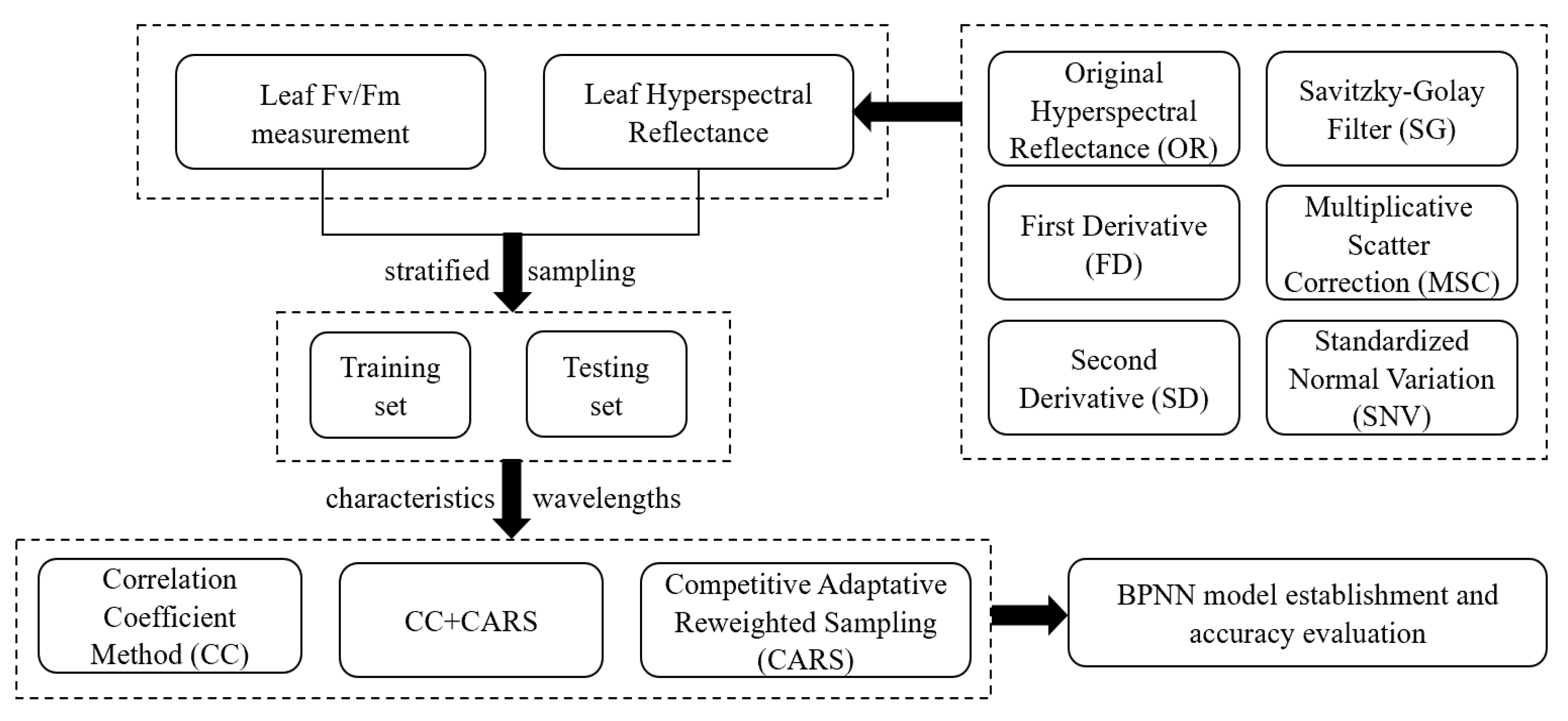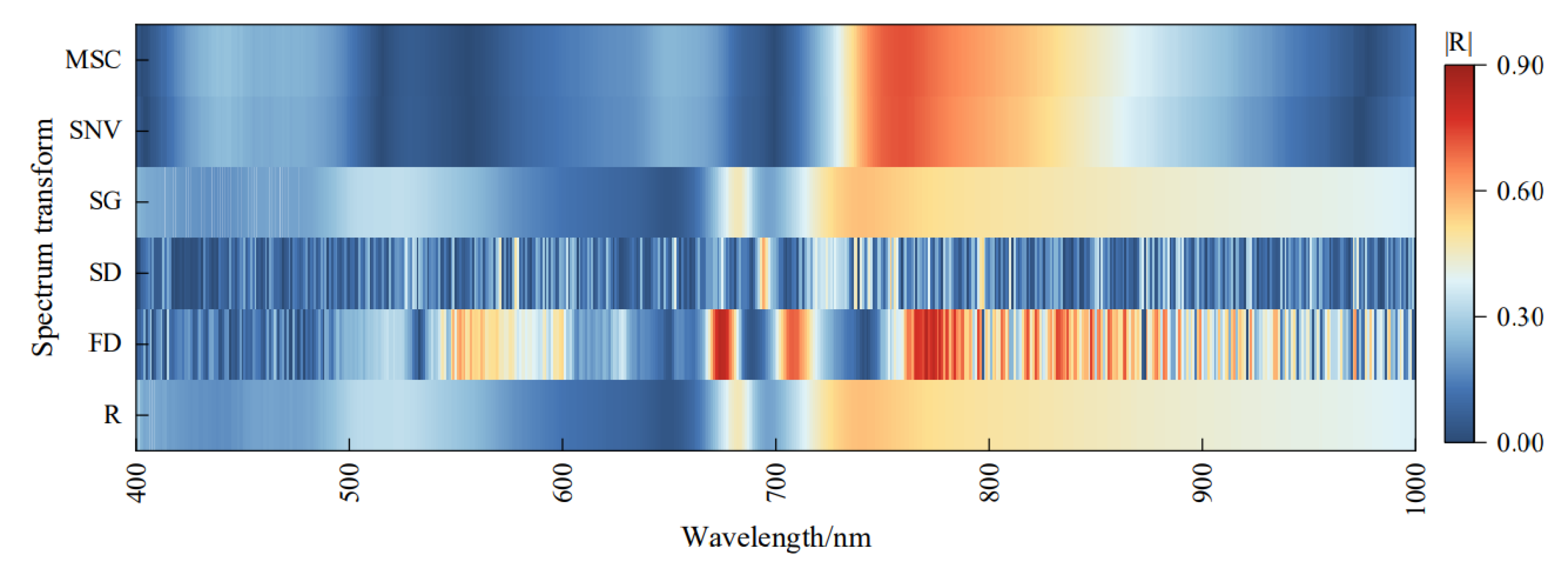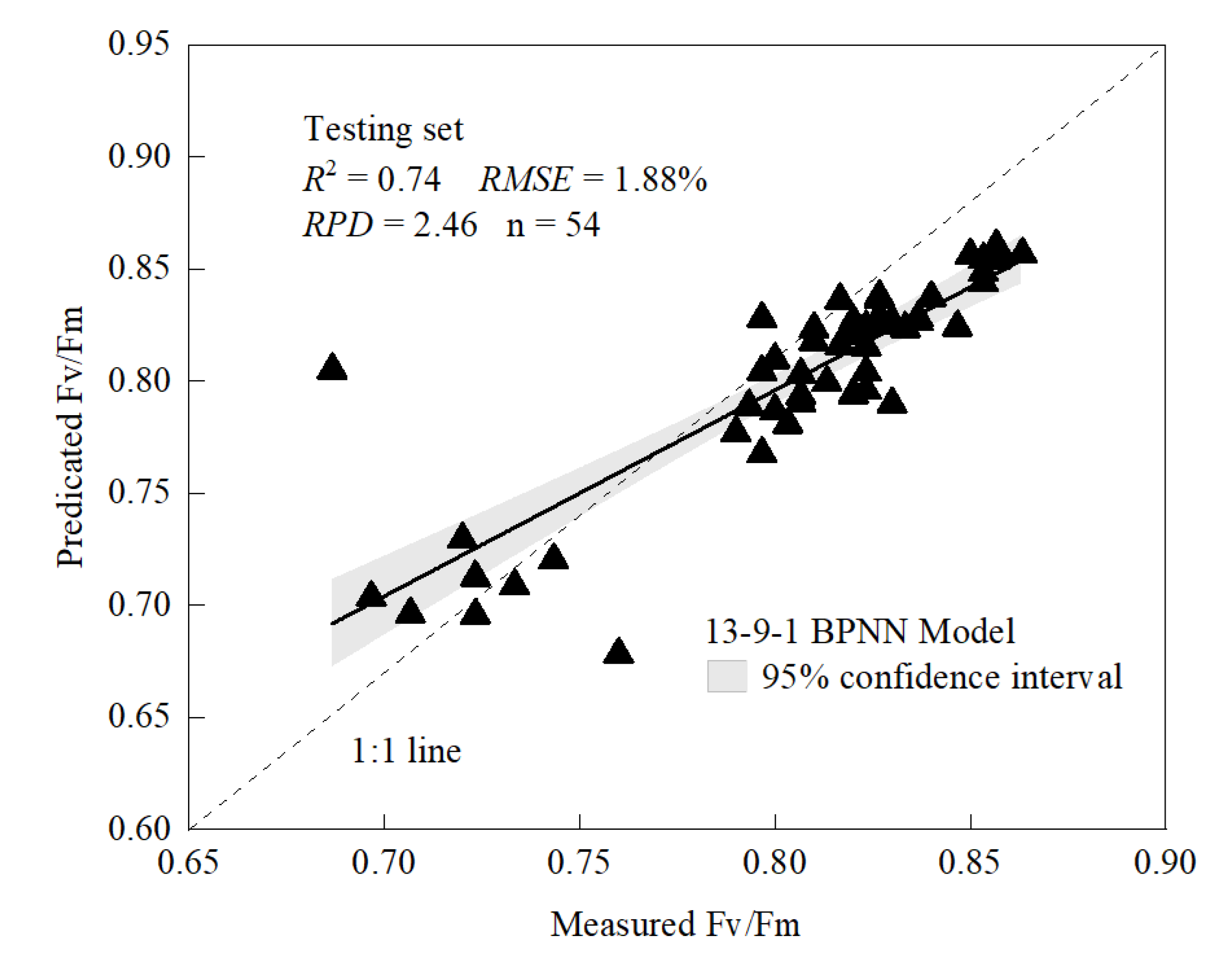Estimating Chlorophyll Fluorescence Parameters of Rice (Oryza sativa L.) Based on Spectrum Transformation and a Joint Feature Extraction Algorithm
Abstract
1. Introduction
2. Materials and Methods
2.1. Experimental Design
2.2. Data Collection
2.3. Data Processing
2.3.1. Sample Division
2.3.2. Spectral Transformation
2.3.3. Spectral Feature Extraction
2.3.4. Model Construction and Accuracy Evaluation
3. Results
3.1. Spectral Data Transformation
3.2. Spectral Feature Extraction Based on the CC and CARS Methods
3.3. BPNN Model Construction and Accuracy Evaluation
4. Discussion
5. Conclusions
Author Contributions
Funding
Institutional Review Board Statement
Informed Consent Statement
Data Availability Statement
Conflicts of Interest
References
- Porcar-Castell, A.; Tyystjärvi, E.; Atherton, J.; van der Tol, C.; Flexas, J.; Pfündel, E.E.; Moreno, J.; Frankenberg, C.; Berry, J.A. Linking chlorophyll a fluorescence to photosynthesis for remote sensing applications: Mechanisms and challenges. J. Exp. Bot. 2014, 65, 4065–4095. [Google Scholar] [CrossRef] [PubMed]
- Tan, C.W.; Wang, D.L.; Zhou, J.; Du, Y.; Luo, M.; Zhang, Y.J.; Guo, W.S. Assessment of Fv/Fm absorbed by wheat canopies employing in situ hyperspectral vegetation indexes. Sci. Rep. 2018, 8, 9525. [Google Scholar] [CrossRef] [PubMed]
- Zheng, W.; Lu, X.; Li, Y.; Li, S.; Zhang, Y.Z. Hyperspectral identification of chlorophyll fluorescence parameters of Suaeda salsa in coastal wetlands. Remote Sens. 2021, 13, 2066. [Google Scholar] [CrossRef]
- Schreiber, U. Chlorophyll fluorescence as a tool in plant physiology I. The measuring systems. Photosynth. Res. 1983, 4, 361–373. [Google Scholar] [CrossRef] [PubMed]
- Bolhar-Nordenkampf, H.R.; Long, S.P.; Baker, N.R.; Oquist, G.; Schreiber, U.; Lechner, E.G. Chlorophyll fluorescence as a probe of the photosynthetic competence of leaves in the field: A review of current instrumentation. Funct. Ecol. 1989, 3, 497–514. [Google Scholar] [CrossRef]
- Kalaji, H.M.; Schansker, G.; Brestic, M.; Bussoyyi, F.; Calatyud, A.; Ferroni, L.; Goltsev, V.; Guidi, L.; Jajoo, A.; Li, P.; et al. Frequently asked questions about chlorophyll fluorescence, the sequel. Photosynth. Res. 2017, 132, 13–66, Erratum in Photosynth. Res. 2017, 132, 67–68. [Google Scholar] [CrossRef]
- Schreiber, U.; Bilger, W.; Neubauer, C. Chlorophyll fluorescence as a nonintrusive indicator for rapid assessment of in vivo photosynthesis. In Ecophysiology of Photosynthesis; Schulze, E.-D., Caldwell, M.M., Eds.; Springer: Berlin, Germany, 1995; pp. 49–70. [Google Scholar] [CrossRef]
- Ni, Z.Y.; Lu, Q.F.; Huo, H.Y.; Zhang, H.L. Estimation of chlorophyll fluorescence at different scales: A review. Sensors 2019, 19, 3000. [Google Scholar] [CrossRef]
- Yu, W.J.; Korner, O.; Schmidt, U. Crop photosynthetic performance monitoring based on a combined system of measured and modelled chloroplast electron transport rate in greenhouse tomato. Front. Plant Sci. 2020, 11, 1038. [Google Scholar] [CrossRef]
- Feng, W.; He, L.; Zhang, H.Y.; Guo, B.B.; Zhu, Y.J.; Wang, C.Y.; Guo, T.C. Assessment of plant nitrogen status using chlorophyll fluorescence parameters of the upper leaves in winter wheat. Eur. J. Agron. 2015, 64, 78–87. [Google Scholar] [CrossRef]
- Hazrati, S.; Sarvestani, Z.T.; Modarres-Sanavy, S.A.M.; Mokhtassi-Bidgoli, A.; Nicola, S. Effects of water stress and light intensity on chlorophyll fluorescence parameters and pigments of Aloe vera L. Plant Physiol. Biochem. 2016, 106, 141–148. [Google Scholar] [CrossRef]
- Cen, H.Y.; Yao, J.N.; Weng, H.Y.; Xu, H.X.; Zhu, Y.M.; He, Y. Applications of chlorophyll fluorescence in plant phenotyping: A review. Spectrosc. Spectr. Anal. 2018, 38, 3773–3779. [Google Scholar] [CrossRef]
- Zhao, R.M.; Xing, Z.Z.; Ma, X.Y.; Song, D.; Li, M.Z.; Sun, H. Correlation analysis and detection of photochemical absorption and reflectance spectra of potato leaves. Trans. Chin. Soc. Agric. Mac. 2020, 51, 375–381. [Google Scholar] [CrossRef]
- Xue, Z.C.; Gao, H.Y.; Peng, T.; Yao, G. Application of spectral reflectance on research of plant eco-physiology. Plant Physiol. J. 2011, 47, 313–320. [Google Scholar] [CrossRef]
- Butler, W.L.; Kitajima, M. Fluorescence quenching in photosystem II of chloroplasts. Biochim. Biophys. Acta 1975, 376, 116–125. [Google Scholar] [CrossRef]
- Hikosaka, K.; Tsujimoto, K. Linking remote sensing parameters to CO2 assimilation rates at a leaf scale. J. Plant Res. 2021, 134, 695–711. [Google Scholar] [CrossRef]
- Zhang, H.; Zhu, L.F.; Hu, H.; Zheng, K.F.; Jin, Q.Y. Monitoring leaf chlorophyll fluorescence with spectral reflectance in Rice (Oryza sativa L.). Procedia Eng. 2011, 15, 4403–4408. [Google Scholar] [CrossRef]
- Jia, M.; Li, D.; Colombo, R.; Wang, Y.; Wang, X.; Cheng, T.; Zhu, Y.; Yao, X.; Xu, C.; Ouer, G.; et al. Quantifying chlorophyll fluorescence parameters from hyperspectral reflectance at the leaf scale under various nitrogen treatment regimes in winter wheat. Remote Sens. 2019, 11, 2838. [Google Scholar] [CrossRef]
- Zhao, R.; An, L.; Song, D.; Li, M.; Qiao, L.; Liu, N.; Sun, H. Detection of chlorophyll fluorescence parameters of potato leaves based on continuous wavelet transform and spectral analysis. Spectrochim. Acta Pt. A Mol. Biomol. Spectrosc. 2021, 259, 119768. [Google Scholar] [CrossRef]
- Yang, Z.F.; Tian, J.C.; Feng, K.P.; Gong, X.; Liu, J.B. Application of a hyperspectral imaging system to quantify leaf-scale chlorophyll, nitrogen and chlorophyll fluorescence parameters in grapevine. Plant Physiol. Biochem. 2021, 166, 723–737. [Google Scholar] [CrossRef]
- Tan, C.W.; Huang, W.J.; Jin, X.L.; Wang, J.C.; Tong, L.; Wang, J.H.; Guo, W.S. Monitoring the chlorophyll fluorescence parameter Fv/Fm in compact corn based on different hyperspectral vegetation indices. Spectrosc. Spectr. Anal. 2012, 32, 1287–1291. [Google Scholar] [CrossRef]
- Li, B.; Gao, P.; Feng, P.; Chen, D.Y.; Zhang, H.H.; Hu, J. Prediction of eggplant leaf Fv/Fm based on Vis-NIR spectroscopy. Spectrosc. Spectr. Anal. 2020, 40, 2834–2839. [Google Scholar] [CrossRef]
- Wang, D.; Shen, K.C.; Fan, Y.M.; Long, B.W. Prediction method of chlorophyll fluorescence Fv/Fm image based on hyperspectral image. Trans. Chin. Soc. Agric. Mac. 2022, 53, 192–198. [Google Scholar] [CrossRef]
- Mohammadi-Moghaddam, T.; Razavi, S.M.A.; Taghizadeh, M.; Pradhan, B.; Sazgarnia, A.; Shaker-Ardekani, A. Hyperspectral imaging as an effective tool for prediction the moisture content and textural characteristics of roasted pistachio kernels. J. Food Measure. Characteriz. 2018, 12, 1493–1502. [Google Scholar] [CrossRef]
- Shen, L.Z.; Gao, M.F.; Yan, J.W.; Li, Z.L.; Leng, P.; Yang, Q.; Duan, S.B. Hyperspectral estimation of soil organic matter content using different spectral preprocessing techniques and PLSR method. Remote Sens. 2020, 12, 1206. [Google Scholar] [CrossRef]
- Wen, S.Y.; Shi, N.; Lu, J.W.; Gao, Q.W.; Hu, W.R.; Cao, Z.D.Y.; Lu, J.X.; Yang, H.B.; Gao, Z.Q. Continuous wavelet transform and back propagation neural network for condition monitoring chlorophyll fluorescence parameters Fv/Fm of rice leaves. Agriculture 2022, 12, 1197. [Google Scholar] [CrossRef]
- Cui, S.C.; Zhou, K.F.; Ding, R.F.; Zhao, J.; Du, X.S.H. Comparing the effects of different spectral transformations on the estimation of the copper content of Seriphidium terrae-Albae. J. Appl. Remote Sens. 2018, 12, 036003. [Google Scholar] [CrossRef]
- Jing, X.; Yan, J.M.; Zou, Q.; Li, B.Y.; Du, K.Q. Remote sensing monitoring of wheat stripe rust based on CC-MPA feature optimization algorithm. Trans. Chin. Soc. Agric. Mac. 2022, 53, 217–225+304. [Google Scholar] [CrossRef]
- Li, H.D.; Liang, Y.Z.; Xu, Q.S.; Cao, D.S. Key wavelengths screening using competitive adaptive reweighted sampling method for multivariate calibration. Anal. Chim. Acta 2009, 648, 77–84. [Google Scholar] [CrossRef]
- Zhang, Y.; Bai, L.C.; Qi, Y.; Huang, H.S.; Lu, X.Y.; Xiao, J.Q.; Lan, Y.B.; Lin, M.H.; Deng, J.Z. Detection of rice spikelet flowering for hybrid rice seed production using hyperspectral technique and machine learning. Agriculture 2022, 12, 755. [Google Scholar] [CrossRef]
- Peñuelas, J.; Filella, I. Visible and near-infrared reflectance techniques for diagnosing plant physiological status. Trends Plant Sci. 1998, 3, 151–156. [Google Scholar] [CrossRef]
- Song, X.Z.; Tang, G.; Zhang, L.D.; Xiong, Y.M.; Min, S.G. Research advance of variable selection algorithms in near infrared spectroscopy analysis. Spectrosc. Spectr. Anal. 2017, 37, 1048–1052. [Google Scholar] [CrossRef]
- Xiao, Q.L.; Tang, W.T.; Zhang, C.; Zhou, L.; Feng, L.; Shen, J.X.; Yan, T.Y.; Gao, R.; He, Y.; Wu, N. Spectral preprocessing combined with deep transfer learning to evaluate chlorophyll content in cotton leaves. Plant Phenom. 2022, 2022, 9813841. [Google Scholar] [CrossRef]
- Meroni, M.; Rossini, M.; Guanter, L.; Alonso, L.; Rascher, U.; Colombo, R.; Moreno, J. Remote sensing of solar-induced chlorophyll fluorescence: Review of methods and applications. Remote Sens. Environ. 2009, 113, 2037–2051. [Google Scholar] [CrossRef]
- Huang, Z.; Turner, B.J.; Dury, S.J.; Wallis, I.R.; Fole, W.J. Estimating foliage nitrogen concentration from HYMAP data using continuum removal analysis. Remote Sens. Environ. 2004, 93, 18–29. [Google Scholar] [CrossRef]
- Hong, Y.S.; Shen, R.L.; Cheng, H.; Chen, Y.Y.; Zhang, Y.; Liu, Y.L.; Zhou, M.; Yu, L.; Liu, Y.; Liu, Y.F. Estimating lead and zinc concentrations in peri-urban agricultural soils through reflectance spectroscopy: Effects of fractional-order derivative and random forest. Sci. Total Environ. 2019, 651, 1969–1982. [Google Scholar] [CrossRef]
- Feng, Z.H.; Li, X.; Duan, J.Z.; Gao, F.; He, L.; Yang, T.C.; Rong, Y.S.; Song, L.; Yin, F.; Feng, W. Hyperspectral remote sensing monitoring of wheat powdery mildew based on feature band selection and machine learning. Acta Agron. Sin. 2022, 48, 2300–2314. [Google Scholar] [CrossRef]
- Marrs, J.K.; Reblin, J.S.; Logan, B.A.; Allen, D.W.; Reinmann, A.B.; Bombard, D.M.; Tabachnik, D.; Hutyra, L.R. Solar-induced fluorescence does not track photosynthetic carbon assimilation following induced stomatal closure. Geophys. Res. Lett. 2020, 47, e2020GL087956. [Google Scholar] [CrossRef]
- Magney, T.S.; Frankenberg, C.; Fisher, J.B.; Sun, Y.; North, G.B.; Davis, T.S.; Kornfeld, A.; Siebke, K. Connecting active to passive fluorescence with photosynthesis: A method for evaluating remote sensing measurements of Chl fluorescence. New Phytol. 2017, 215, 1594–1608. [Google Scholar] [CrossRef]
- Kohzuma, K. Evaluation of photosynthetic behaviors by simultaneous measurements of leaf reflectance and chlorophyll fluorescence analyses. J. Vis. Exp. 2019, 150, e59838. [Google Scholar] [CrossRef]
- Tsujimoto, K.; Hikosaka, K. Estimating leaf photosynthesis of C3 plants grown under different environments from pigment index, photochemical reflectance index, and chlorophyll fluorescence. Photosynth. Res. 2021, 148, 33–46. [Google Scholar] [CrossRef]
- Ding, J.X.; Zhou, L.; Wang, Y.L.; Zhuang, J.; Chen, J.J.; Zhou, W.; Zhao, N.; Song, J.; Chi, Y.G. Application prospects for combining active and passive observations of chlorophyll fluorescence. Chin. J. Plant Ecol. 2021, 45, 105–118. [Google Scholar] [CrossRef]





| Treatments | N1 | N2 | N3 | |
|---|---|---|---|---|
| Base fertilizer (kg/hm2) | 15–15–15 compound fertilizer | 300 | 300 | 300 |
| lime | 600 | 600 | 600 | |
| Tillering fertilizer (kg/hm2) | 15–15–15 compound fertilizer | 300 | 150 | 0 |
| urea | 225 | 150 | 75 | |
| Panicle fertilizer (kg/hm2) | 15–15–15 compound fertilizer | 75 | 75 | 75 |
| KCI | 45 | 45 | 45 | |
| Sample Set | Size | Max. | Min. | Mean | CV (%) |
|---|---|---|---|---|---|
| All | 162 | 0.86 | 0.66 | 0.81 | 5.54 |
| Training set | 108 | 0.86 | 0.66 | 0.81 | 5.64 |
| Testing set | 54 | 0.86 | 0.69 | 0.81 | 5.34 |
| Spectrum Transform | Training Set | Testing Set | ||||
|---|---|---|---|---|---|---|
| RC2 | RMSEC (%) | RV2 | RMSEV (%) | RPD | ||
| Linear equation | OR | 0.32 | 3.72 | 0.19 | 3.90 | 0.49 |
| FD | 0.70 | 2.49 | 0.64 | 2.86 | 1.42 | |
| SD | 0.36 | 3.49 | 0.28 | 3.62 | 0.66 | |
| SG | 0.32 | 3.71 | 0.19 | 3.89 | 0.49 | |
| MSC | 0.53 | 3.24 | 0.47 | 3.10 | 1.03 | |
| SNV | 0.52 | 3.23 | 0.47 | 3.09 | 1.02 | |
| Exponential equation | OR | 0.32 | 3.74 | 0.19 | 3.93 | 0.50 |
| FD | 0.69 | 2.56 | 0.63 | 2.96 | 1.40 | |
| SD | 0.35 | 3.53 | 0.28 | 3.66 | 0.67 | |
| SG | 0.32 | 3.74 | 0.19 | 3.92 | 0.50 | |
| MSC | 0.52 | 3.30 | 0.46 | 3.17 | 1.05 | |
| SNV | 0.51 | 3.28 | 0.46 | 3.16 | 1.04 | |
| Logarithmic equation | OR | 0.32 | 3.69 | 0.20 | 3.88 | 0.48 |
| FD | - | - | - | - | - | |
| SD | 0.37 | 3.45 | 0.28 | 3.60 | 0.68 | |
| SG | 0.32 | 3.68 | 0.20 | 3.87 | 0.48 | |
| MSC | 0.53 | 3.23 | 0.48 | 3.08 | 1.03 | |
| SNV | 0.53 | 3.21 | 0.48 | 3.05 | 1.03 | |
| Quadratic polynomial equation | OR | 0.32 | 3.71 | 0.19 | 3.90 | 0.49 |
| FD | 0.75 | 2.26 | 0.66 | 2.66 | 1.75 | |
| SD | 0.37 | 11.4 | 0.27 | 10.9 | 0.35 | |
| SG | 0.32 | 3.72 | 0.19 | 3.90 | 0.49 | |
| MSC | 0.58 | 2.95 | 0.55 | 2.68 | 1.12 | |
| SNV | 0.56 | 2.99 | 0.54 | 2.72 | 1.09 | |
| Spectrum Transform | Number of Variables | Wavelength Selection (nm) | |
|---|---|---|---|
| CARS | FD | 41 | 463, 477, 482, 485–486, 495, 511, 513, 527, 529–530, 600, 642–643, 684, 699, 706–707, 750 762–763, 771, 775, 795, 851, 859, 863, 877–878, 912, 917, 944, 957, 965, 969, 983, 990–992, 994, 997 |
| MSC | 37 | 400, 404–406, 408–410, 412, 417–418, 421, 423, 427, 430, 436, 442–444, 452, 463, 499 554–555, 583, 659–661, 691–692, 704–705, 727, 907, 911, 930, 984, 998 | |
| SNV | 26 | 403, 405, 408–410, 418, 421, 423, 430, 436, 442–444, 452–453 463, 671–672, 691–692, 702–703, 724, 911, 930, 998 | |
| CC-CARS | FD | 14 | 678–679, 707–710, 774–795, 832, 835 837, 864, 882, 889 |
| MSC | 13 | 742–743, 747, 753, 758, 773, 775, 785–786, 788, 794, 795, 800 | |
| SNV | 16 | 744, 746, 749, 753, 767, 773, 775, 785–786, 788, 790, 794–797, 800 | |
| Spectrum Transform | Training Set | Testing Set | ||||
|---|---|---|---|---|---|---|
| RC2 | RMSEC (%) | RV2 | RMSEV (%) | RPD | ||
| CC | FD | 0.90 | 1.44 | 0.69 | 2.07 | 1.92 |
| MSC | 0.86 | 1.50 | 0.70 | 1.91 | 2.26 | |
| SNV | 0.83 | 1.87 | 0.69 | 2.10 | 1.94 | |
| CARS | FD | 0.90 | 1.27 | 0.70 | 2.24 | 1.94 |
| MSC | 0.84 | 1.77 | 0.68 | 2.47 | 1.83 | |
| SNV | 0.84 | 1.64 | 0.65 | 2.23 | 1.71 | |
| CC-CARS | FD | 0.91 | 1.20 | 0.72 | 2.24 | 1.98 |
| MSC | 0.86 | 1.50 | 0.74 | 1.88 | 2.46 | |
| SNV | 0.85 | 1.54 | 0.72 | 1.91 | 2.39 | |
Disclaimer/Publisher’s Note: The statements, opinions and data contained in all publications are solely those of the individual author(s) and contributor(s) and not of MDPI and/or the editor(s). MDPI and/or the editor(s) disclaim responsibility for any injury to people or property resulting from any ideas, methods, instructions or products referred to in the content. |
© 2023 by the authors. Licensee MDPI, Basel, Switzerland. This article is an open access article distributed under the terms and conditions of the Creative Commons Attribution (CC BY) license (https://creativecommons.org/licenses/by/4.0/).
Share and Cite
Wen, S.; Shi, N.; Lu, J.; Gao, Q.; Yang, H.; Gao, Z. Estimating Chlorophyll Fluorescence Parameters of Rice (Oryza sativa L.) Based on Spectrum Transformation and a Joint Feature Extraction Algorithm. Agronomy 2023, 13, 337. https://doi.org/10.3390/agronomy13020337
Wen S, Shi N, Lu J, Gao Q, Yang H, Gao Z. Estimating Chlorophyll Fluorescence Parameters of Rice (Oryza sativa L.) Based on Spectrum Transformation and a Joint Feature Extraction Algorithm. Agronomy. 2023; 13(2):337. https://doi.org/10.3390/agronomy13020337
Chicago/Turabian StyleWen, Shuangya, Nan Shi, Junwei Lu, Qianwen Gao, Huibing Yang, and Zhiqiang Gao. 2023. "Estimating Chlorophyll Fluorescence Parameters of Rice (Oryza sativa L.) Based on Spectrum Transformation and a Joint Feature Extraction Algorithm" Agronomy 13, no. 2: 337. https://doi.org/10.3390/agronomy13020337
APA StyleWen, S., Shi, N., Lu, J., Gao, Q., Yang, H., & Gao, Z. (2023). Estimating Chlorophyll Fluorescence Parameters of Rice (Oryza sativa L.) Based on Spectrum Transformation and a Joint Feature Extraction Algorithm. Agronomy, 13(2), 337. https://doi.org/10.3390/agronomy13020337






